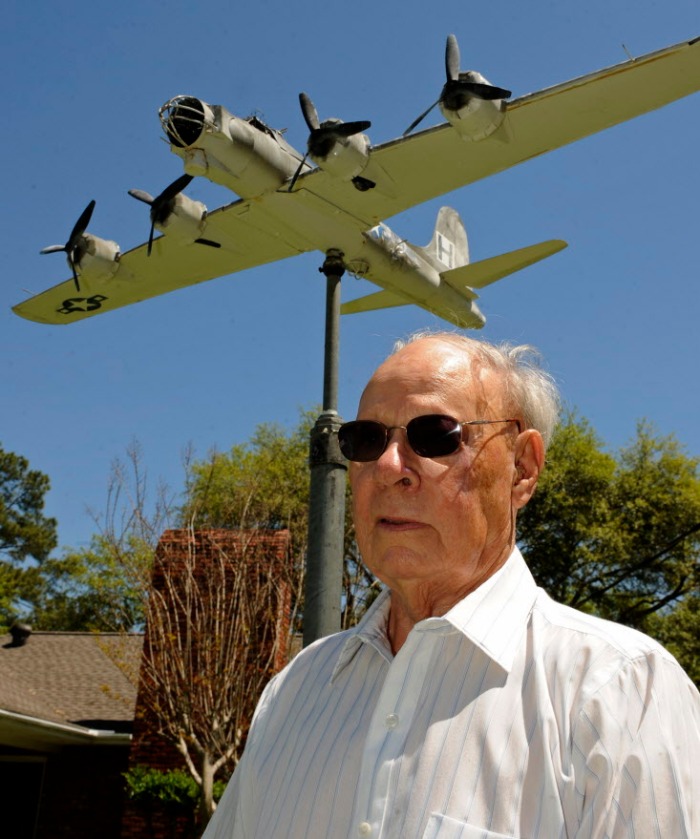 Charles McGowan kept a B-17 wind indicator in his back yard. (Photo used by permission of The Advocate, Baton Rouge, Louisiana)
Charles McGowan kept a B-17 wind indicator in his back yard. (Photo used by permission of The Advocate, Baton Rouge, Louisiana)
By George Morris
From an exclusively visual perspective, Charles “Chub” McGowan had the best seat during the air war over Germany late in World War II.
Sightseeing, however, wasn’t on the agenda.
McGowan, a Pennsylvania native and Baton Rouge resident since 1969, was a ball turret gunner from late July 1944 to late February 1945, when the crew of the B-17 bomber called “Patty Jo” completed their 35th mission, earning them that rare blessing of being sent back to the United States for the rest of the war. With thousands of airmen killed or captured, those completing a full tour of duty earned membership in the “Lucky Bastard Club.”
None of them probably felt luckier than the ball turret gunner.
Stuffing themselves into a small, round compartment that hung below the fuselage, ball turret gunners were isolated from the rest of the crew except for being able to speak through an intercom. Most gunners could not bring their parachutes with them into the turret, and on long missions they would have to stay inside for eight hours or more, on guard against enemy fighter planes attacking from any direction, and especially below.
“It’s the worst (place) on the plane,” McGowan said. “I got in it just by luck.”
McGowan had been assigned as one of two waist gunners on a 10-man B-17 crew that was assembled in Florida. But, when crews were ordered to trim to nine men, the “Patty Jo” pilot had to make a choice. McGowan suggested cutting the ball turret gunner, who had been hospitalized and had not joined the rest of the crew.
“He looked at me and said, ‘Will you fly the ball?’,” he said. “And I said, ‘Yeah, I’ll fly it.’ I was really too big.”
That was true even though, at 5 feet 8, McGowan was no giant. When the B-17 was airborne, he would remove the arming pins from the bombs, and when the airplane left England, he would descend into the ball turret. There he would remain until the bomber reached England again. Equipped with two .50-caliber machine guns, the turret could rotate 360 degrees, and its guns could tilt downward in any direction.
All crewmen had to deal with severe conditions that resulted in flying at altitudes as high as 30,000 feet in an airplane not built for comfort. All of them were hooked up to oxygen and had heated flight suits.
The ball turret had a chute that allowed the bullet casings to fall out. McGowan decided he preferred thecasings to the drafty conditions.
“You’re up there at 30,000 feet, that air, we’d seen it as low as 85 below zero, and a lot of air came in through there,” he said. “So, I’d go outside the plane (before taking off) and if that chute was on there, I’d tear it off and stuff those holes up with rags and let those shells fall over my legs.”
Those guns got plenty of use, especially on early missions, when U.S. fighter escorts could not follow bombers all the way to their targets. The development of the longer-range P-51 Mustang fighter gave the bombers more protection.
The ball turret allowed the gunner to see more than any other crewman, even the pilot, who could only see forward and a little to each side. He could see the bombs hitting and often knew of approaching enemy planes before anyone else.
“Dogfights, I had a ringside seat,” McGowan said.
That also allowed him to see Germany’s greatest aeronautical breakthrough, the world’s first jet fighter planes. On one mission, McGowan saw four jet fighters attack a nearby bomber formation. Unlike Germany’s conventional fighters, the jets attacked the bombers even as they were flying through antiaircraft fire.
“From that ball turret I saw men, parachutes, clothing, stuff flying past that ball turret,” he said. “It was black out there. You got so gosh-awful mad you were ready to shoot anybody down. That was the worst I saw. These four jets stayed right on them and worked them over. I forget how many they lost. They lost quite a lot of them.”
The “Patty Jo” had its share of close calls, once returning with 176 holes, mostly from antiaircraft fire. Once, McGowan had to kick a bomb that had gotten stuck in the bomb bay so it could fall from the plane.
On another mission, flak cut wires that provided electric power to the wing flaps and the rear of the plane, including the heated suits. McGowan used hand cranks to keep turning the turret so enemies wouldn’t realize the extent of the damage. When the “Patty Jo” crossed the English Channel, McGowan got out of the turret and repaired the wires.
“I stayed in that turret for two hours with no heat and no juice,” he said. “I got out of that turret and, man, I could hardly straighten up.”
When the “Patty Jo” returned to England on Feb. 16, 1945, it marked the last trip to enemy territory both for the crew and the airplane, which had flown on a total of 110 bombing missions. The “Patty Jo” toured the country on war bond drives, and McGowan was stationed in Alabama and Mississippi until the war ended.
“It was an experience,” he said.